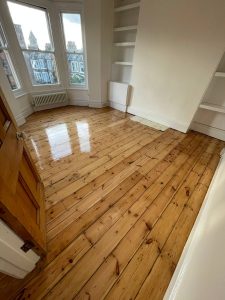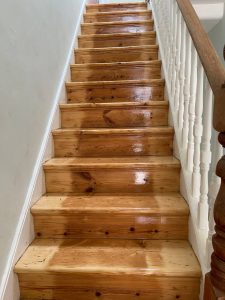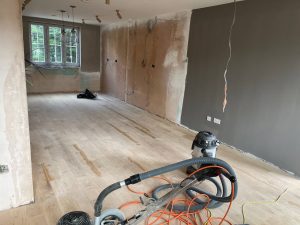How to Deal with Floor Cupping and Crowning Before Sanding

Effective methods to restore your wooden floors in your London home
Understanding Floor Cupping and Crowning
Floor cupping and crowning are common issues that affect wooden floors, often caused by changes in moisture levels. Here’s a brief overview:
- Cupping: Cupping occurs when the edges of a floorboard are higher than the centre, creating a concave shape. This is typically due to moisture being absorbed from the underside of the flooring.
- Crowning: Crowning happens when the centre of a floorboard is higher than the edges, resulting in a convex shape. This usually occurs when the top of the floor is exposed to moisture, or if cupped floors are sanded before they are properly dried.
Identifying the Causes
Before addressing cupping or crowning, it’s crucial to identify and rectify the underlying causes to prevent recurrence. Common causes include:
- Moisture Imbalance: Changes in humidity levels or moisture intrusion from leaks or spills can cause uneven moisture distribution in floorboards.
- Improper Installation: Incorrect installation techniques, such as insufficient acclimation of the wood or lack of moisture barriers, can contribute to these issues.
- Environmental Factors: Seasonal changes and inadequate ventilation can lead to moisture-related problems in wooden floors.
Steps to Address Floor Cupping and Crowning
Follow these steps to deal with cupping and crowning before sanding your floors:
1. Address Moisture Issues
Identify and eliminate the source of moisture. This may involve repairing leaks, improving ventilation, or using dehumidifiers to maintain stable indoor humidity levels.
2. Allow Time for Drying
Give the affected floorboards time to dry and acclimate to the room’s environment. This process can take several weeks, depending on the extent of the moisture problem.
3. Assess the Damage
Once the floorboards have dried, assess the extent of the cupping or crowning. If the damage is minor, the boards may return to their original shape on their own. For more severe cases, further intervention may be required.
4. Sanding and Refinishing
If the floorboards remain uneven after drying, sanding can help restore a flat surface. Here’s how to proceed:
- Sand with Caution: Begin sanding with a coarse grit sandpaper to level the surface. Use a floor sander for large areas and a hand sander for edges and corners.
- Check for Evenness: Periodically check the floor for evenness during sanding. Avoid over-sanding, as this can weaken the floorboards.
- Refinish the Floors: After sanding, apply a suitable finish to protect the wood and enhance its appearance. Choose a finish that matches your desired aesthetic and provides adequate protection against moisture.
Preventing Future Issues
Implement these preventive measures to avoid future cupping and crowning:
- Maintain Consistent Humidity: Use humidifiers or dehumidifiers to maintain consistent indoor humidity levels, ideally between 40% and 60%.
- Ensure Proper Installation: Hire experienced professionals to install your wooden floors, ensuring they follow best practices for acclimation and moisture barriers.
- Regular Maintenance: Regularly inspect your floors for signs of moisture damage and address any issues promptly.
Professional Help
Dealing with floor cupping and crowning can be challenging. For the best results, consider hiring professional floor restoration services. If you’re in London and need expert assistance, contact us today. Our experienced team is here to help you restore and maintain the beauty of your wooden floors.







WOOD FLOOR SANDING AND LACQUERING/SEALING
[Read more...]
Floor Sanding for Commercial Properties: What You Need to Know
Floor sanding is not only essential for residential spaces but also plays a crucial role[Read more...]
How to Create a Seamless Transition Between Rooms with Floor Sanding
How to Create a Seamless Transition Between Rooms with Floor Sanding Achieve a uniform[Read more...]
How to Handle Floor Stains from Pets
How to Handle Floor Stains from Pets Pets bring joy and companionship to our homes,[Read more...]
The Benefits of Floor Sanding for Open House Showings
London Property Tips Home About Contact The Benefits of Floor Sanding for Open House[Read more...]
Buffing and one coat finish
[Read more...]
Understanding the Cost Breakdown of Floor Sanding Services
Understanding the Cost Breakdown of Floor Sanding Services Learn About the Factors[Read more...]
The History and Evolution of Floor Sanding Techniques
Floor sanding is a crucial process in maintaining the beauty and longevity of wooden floors.[Read more...]
Innovations in Floor Sanding Technology
The field of floor sanding has seen significant advancements in recent years, making the process[Read more...]
The Best Rugs and Mats for Protecting Sanded Floors
The Best Rugs and Mats for Protecting Sanded Floors Maintain your wooden floors with[Read more...]